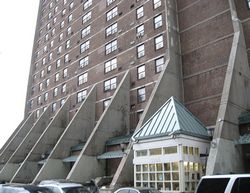 Melrose is a residential neighborhood in the New York City borough of the Bronx. It is north of Mott Haven and west of Longwood, and considered as part of the South Bronx. The neighborhood is part of Bronx Community Board 1. Its boundaries, starting from the north and moving clockwise are: East 161st Street to the north, Prospect Avenue to the east, East 149th Street to the south, and Park Avenue to the west. Melrose Avenue is the primary thoroughfare through Melrose. The southeastern corner of the neighborhood is served by the 2 and 5 line at Jackson Avenue, operating along Westchester Avenue. ZIP codes include 10451, 10455, and 10456. The neighborhood is served by the NYPD’s 40th Precinct.
Melrose is a residential neighborhood in the New York City borough of the Bronx. It is north of Mott Haven and west of Longwood, and considered as part of the South Bronx. The neighborhood is part of Bronx Community Board 1. Its boundaries, starting from the north and moving clockwise are: East 161st Street to the north, Prospect Avenue to the east, East 149th Street to the south, and Park Avenue to the west. Melrose Avenue is the primary thoroughfare through Melrose. The southeastern corner of the neighborhood is served by the 2 and 5 line at Jackson Avenue, operating along Westchester Avenue. ZIP codes include 10451, 10455, and 10456. The neighborhood is served by the NYPD’s 40th Precinct.
Melrose has a population of 30,000. For decades Melrose has been one of the poorest communities in America. Over half the population lives below the poverty line and receives public assistance (AFDC, Home Relief, Welfare, and Medicaid). Over one third the population resides in units managed by the NYCHA. Melrose has one of the highest concentrations of Puerto Ricans in all of New York City. The vast majority of households are renter occupied. The neighborhood, like the rest of the South Bronx, is plagued by high levels of gang activity, drug use, prostitution, and homelessness.
Melrose was once predominantly White non-Hispanic. In the 1960s and 70s arson combined with White flight ravaged the community. Most of the original housing stock which consisted of older multi-unit homes and tenements were structurally damaged by arson and eventually razed by the city.
In 1973, the City of New York dismantled the Third Avenue El train, leaving a large portion of the southwestern Bronx underserved by public transportation. There is a direct correlation with the economic disparity of the neighborhoods adjacent to Third Avenue and the lack of viable subway access. The present options are the MTA’s BX55 bus and more recently the Melrose station of the Metro-North Railroad provides transportation into Manhattan. Both options are poor substitutes to the Third Avenue El. The City of New York presently has no plans to replace to Third Avenue El with a new subway line.
After a wave of arson ravaged the low income communities of New York City throughout the 1970s, most residential structures in Melrose were left seriously damaged or destroyed. The city began to rehabilitate many formally abandoned tenement buildings and designate them low income housing beginning in the late 1970s. Also many subsidized attached multi-unit townhouses and newly constructed apartment buildings have been or are being built on vacant lots across across the neighborhood.
